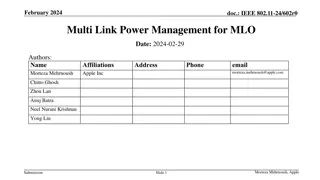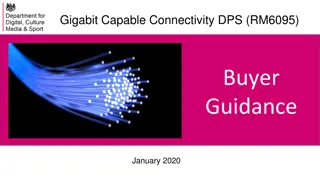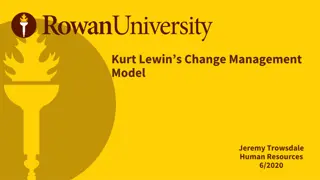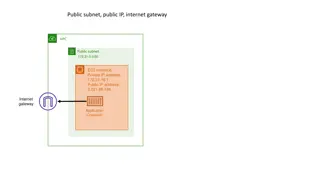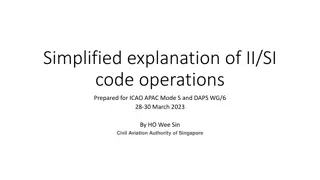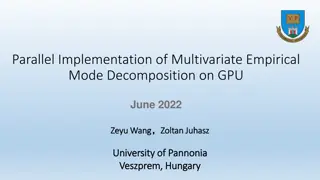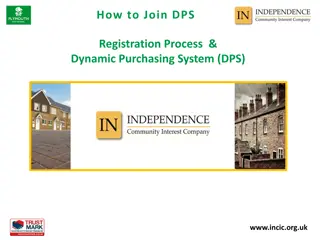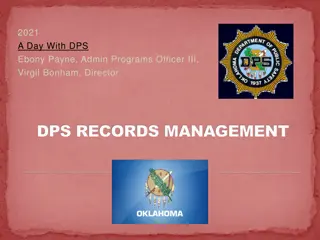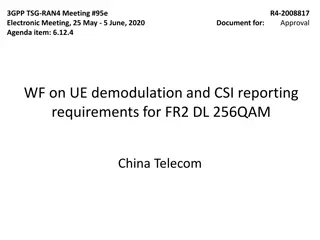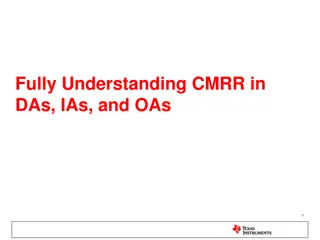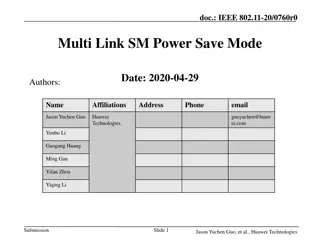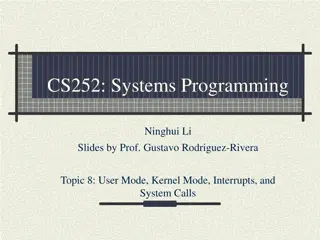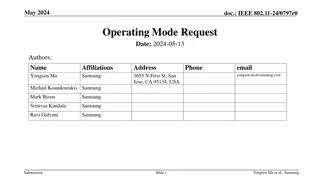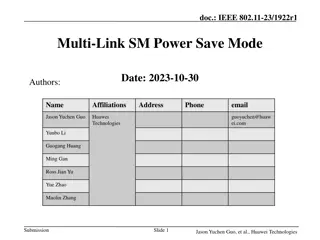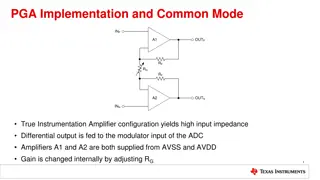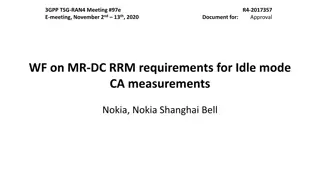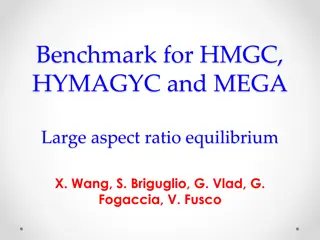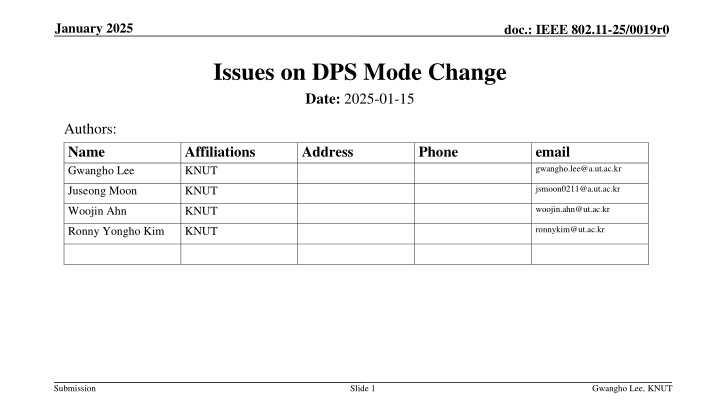
Issues with DPS Mode Change in IEEE 802.11-25/0019r0 Document
Analyzing Dynamic Power Save (DPS) mode transitions from lower capability mode (LCM) to higher capability mode (HCM) in IEEE 802.11-25/0019r0, focusing on challenges faced during DPS operation in TXOP Sharing scenarios and proposing solutions for efficient communication under shared TXOP resources.
Download Presentation

Please find below an Image/Link to download the presentation.
The content on the website is provided AS IS for your information and personal use only. It may not be sold, licensed, or shared on other websites without obtaining consent from the author. If you encounter any issues during the download, it is possible that the publisher has removed the file from their server.
You are allowed to download the files provided on this website for personal or commercial use, subject to the condition that they are used lawfully. All files are the property of their respective owners.
The content on the website is provided AS IS for your information and personal use only. It may not be sold, licensed, or shared on other websites without obtaining consent from the author.
E N D
Presentation Transcript
January 2025 doc.: IEEE 802.11-25/0019r0 Issues on DPS Mode Change Date: 2025-01-15 Authors: Name Gwangho Lee Affiliations KNUT Address Phone email gwangho.lee@a.ut.ac.kr jsmoon0211@a.ut.ac.kr Juseong Moon KNUT woojin.ahn@ut.ac.kr Woojin Ahn KNUT ronnykim@ut.ac.kr Ronny Yongho Kim KNUT Submission Slide 1 Gwangho Lee, KNUT
January 2025 doc.: IEEE 802.11-25/0019r0 Recap: Dynamic Power Save TGbn defines a power save mode for a STA that is a UHR Mobile AP or a UHR non-AP STA wherein the STA may perform transition from lower capability mode (LCM) to higher capability mode (HCM) upon reception of an initial control frame[1] . LCM has lower capability than HCM. E.g., 20 MHz BW, one SS, limited data rates, PPDU format. This power save mode is called Dynamic Power Save (DPS) A STA supports DPS can be called as a DPS STA [2]. An AP supports DPS can be called as a DPS assisting AP [2]. In order for a DPS STA in LCM to transmit PPDUs using full capability in HCM, the DPS STA needs to change its DPS mode from LCM to HCM first and then it transmits PPDUs with its full capability in HCM. In TXOP Sharing, a DPS STA in LCM has a limitation with bandwidth utilization and there are some issues with DPS mode change from LCM to HCM in TXOP Sharing. In this contribution, issues with a DPS operation in TXOP Sharing are discussed. Submission Slide 2 Gwangho Lee, KNUT
January 2025 doc.: IEEE 802.11-25/0019r0 DPS with TXOP Sharing An AP can share its TXOP with a DPS STA using Triggered TXOP sharing (TXS) procedure defined in 35.2.1.2 [3]. A DPS STA can be in LCM, when an AP shares its TXOP. In 35.2.1.2.3 [3], bandwidth can be used by a STA within the shared TXOP is limited by the bandwidth of the CTS frame which the STA transmitted in response to the MU-RTS TXS trigger frame. A non-AP STA addressed by an MU-RTS TXS Trigger frame shall set the TXVECTOR parameter CH_BANDWIDTH or CH_BANDWIDTH_IN_NON_HT of non-TB PPDUs that it transmits during the time allocated by the MU-RTS TXS Trigger frame to be the same or narrower than the TXVECTOR parameter CH_BANDWIDTH_IN_NON_HT of the CTS frame that it transmitted in response to the MU-RTS TXS Trigger frame. The reason why allowing the same or narrower bandwidth of the CTS frame is because of interference from the shared STA s perspective. Because of such limitation, even if a DPS STA in LCM changes its mode to HCM, the DPS STA can only transmit PPDUs with parameters (such as bandwidth) used in LCM within the shared TXOP. In order to enhance the latency and throughput performance of a DPS STA within the shared TXOP, several possible approaches to change a DPS STA s mode from LCM to HCM for TXOP Sharing need to be considered. Submission Slide 3 Gwangho Lee, KNUT
January 2025 doc.: IEEE 802.11-25/0019r0 Limited Capability Issue within Shared TXOP with DPS 35.2.1.2.3 Non-AP STA behavior A non-AP STA addressed by an MU-RTS TXS Trigger frame shall set the TXVECTOR parameter CH_BANDWIDTH or CH_BANDWIDTH_IN_NON_HT of non-TB PPDUs that it transmits during the time allocated by the MU-RTS TXS Trigger frame to be the same or narrower than the TXVECTOR parameter CH_BANDWIDTH_IN_NON_HT of the CTS frame that it transmitted in response to the MU- RTS TXS Trigger frame. If an AP shares its TXOP with a non-AP STA, the non-AP STA can transmit frames in the shared TXOP. If the non-AP STA is a DPS STA in LCM, the shared TXOP s resources (e.g., bandwidth, MCS, NSS, etc.) are limited. This can lead inefficient communication during the shared TXOP. According to 35.2.1.2.3 [3], the non-AP STA s bandwidth within the shared TXOP is limited by the bandwidth of the CTS frame. In this case, this limitation is not because of interference of the non-AP STA s side but because of capability limitation (LCM). Submission Slide 4 Gwangho Lee, KNUT
January 2025 doc.: IEEE 802.11-25/0019r0 Option 1 To address limited capability issue of a DPS STA within shared TXOP, the option 1 can be utilized. The main concept of the option 1 is that allowing the DPS STA to utilize the full capability shared by the AP within the shared TXOP after the DPS STA changes its DPS mode to HCM by the AP s indication. However, in DPS, when to enter and how long remain in LCM is the DPS STA s preference. This may because of the power save policy of the DPS STA, etc. So, the option 1 can be utilized when the DPS STA allows to change its DPS mode to HCM by the AP s indication. Submission Slide 5 Gwangho Lee, KNUT
January 2025 doc.: IEEE 802.11-25/0019r0 Option 2 For an alternative approach, the option 2 can be utilized. The main concept of the option 2 is that the DPS STA can decide to change its DPS mode at the start time of the shared TXOP by it self. With the option 2, the shared TXOP can be utilized with full capability by the DPS STA s decision even the AP can respect the DPS STA s local policy (e.g., power save policy). However, there are several issues for the option 2. Issue 1. Shared TXOP return rule. In TXS mode 1, if time between PPDU transmissions is more than a PIFS slot boundary, the shared TXOP is returned to the AP. This is because, in 11be [3], the AP assumes that the non-AP STA has no more UL data to transmit in the shared TXOP. Issue 2. Bandwidth limitation. As discussed above, there is bandwidth limitation in TXS (limited to CTS s BW), it is needed to ease the current bandwidth limitation. Issue 3. Wider bandwidth expansion in the shared TXOP. The DPS STA may need to perform channel sensing (e.g., PIFS) to utilize the full bandwidth within the shared TXOP after changing its DPS mode to HCM. Submission Slide 6 Gwangho Lee, KNUT
January 2025 doc.: IEEE 802.11-25/0019r0 Summary In this contribution, an issue when an AP shares its TXOP to a DPS STA in LCM was discussed. Due to the limited resources of the DPS STA in LCM and the bandwidth limitation of CTS frame in TXS, the DPS STA s transmission within the shared TXOP can be done inefficiently. There may be more similar cases/issues for DPS STA. To address the issues, two options were proposed. Option 1) The AP indicates the DPS STA to change its DPS mode to HCM prior to the TXS procedure. Option 2) the DPS STA can decide to change its DPS mode to HCM at the start time of the shared TXOP by it self. The general concept of these options is changing DPS mode of DPS STA from LCM to HCM prior to the data transmission in the shared TXOP. Submission Slide 7 Gwangho Lee, KNUT
January 2025 doc.: IEEE 802.11-25/0019r0 References [1] 24/0209r7, Specification Framework for TGbn, Ross Jian Yu (Huawei) [2] 24/1987r2, Detailed text proposal for dynamic power save and eMLSR, Liwen Chu et al. (NXP) [3] Draft P802.11be_D7.0 Submission Slide 8 Gwangho Lee, KNUT

